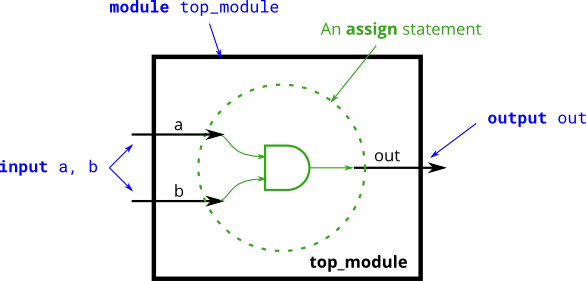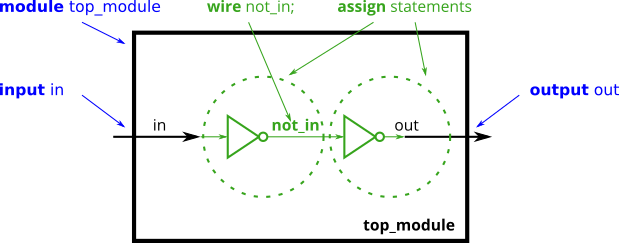Step one
熟悉HDLBits使用的接口。
Q:构建一个没有输入和一个输出的电路。该输出应始终驱动 1(或逻辑高电平)。
module top_module( output one );
// Insert your code here
assign one = 1'b1;
endmodule
A:简单的一个输出电路。已经给出端口定义,输出one。采用assign定义,赋值1’b1的书写,一位的1。
Zero
Q:构建一个没有输入和一个输出常数 0 的输出的电路。
module top_module(
output zero
);// Module body starts after semicolon
assign zero = 1'b0;
endmodule
A:和Step one一样,没什么好说的。这里提示了两种端口定义代码的写法
module top_module ( zero );
output zero;
// Verilog-1995
endmodule
module top_module ( output zero );
// Verilog-2001
endmoduleWire
Q:连续赋值
module top_module( input in, output out );
assign out = in ;
endmodule
A:输入等于输出,assign连接。
Wire4
Q:四根线的连接
module top_module(
input a,b,c,
output w,x,y,z );
assign w =a;
assign x=b;
assign y=b;
assign z=c;
endmodule
Notgate
Q:非门

module top_module( input in, output out );
assign out = ~in;
endmodule
A:基础的非门,assign 输出取反。
Andgate
Q:与门

module top_module(
input a,
input b,
output out );
assign out = a && b;
endmodule
A:与门,与运算符
。。。
Declaring wires
Q:复杂电路,需要电线将内部组件连接在一起。使用电线时,应在模块的主体中声明,在首次使用之前的某个地方。 wire 类型的信号。
例:

module top_module (
input in, // Declare an input wire named "in"
output out // Declare an output wire named "out"
);
wire not_in; // Declare a wire named "not_in"
assign out = ~not_in; // Assign a value to out (create a NOT gate).
assign not_in = ~in; // Assign a value to not_in (create another NOT gate).
endmodule // End of module "top_module"Q:定义wire型信号,并连接。

`default_nettype none
module top_module(
input a,
input b,
input c,
input d,
output out,
output out_n );
wire in1,in2;
assign in1 = a && b ;
assign in2 = c && d ;
assign out = in1 || in2;
assign out_n = ~out;
endmodule
A:例子给的比较明确了。端口定义好输入输出,端口外内部信号说明,这里是wire信号。在功能语句部分直接用到。
7458
7458 是具有四个 AND 门和两个 OR 门的芯片。
创建与 7458 芯片具有相同功能的模块。它有 10 个输入和 2 个输出。
方法一:使用语句来驱动每根输出导线,
方法二:选择声明4根导线用作中间信号。

module top_module (
input p1a, p1b, p1c, p1d, p1e, p1f,
output p1y,
input p2a, p2b, p2c, p2d,
output p2y );
wire w1,w2,w3,w4;
assign w1 = p2a && p2b;
assign w2 = p1a && p1b && p1c;
assign w3 = p2c && p2d;
assign w4 = p1f && p1e && p1d;
assign p2y = w1 || w3;
assign p1y = w4 || w2;
endmoduleA:这里用到定义内部连线的方法。如果不进行内部连线定义,功能描述语句将变得非常长且复杂。
——————————————————————————————————————————
基本的一些语句,其他的改天再整理。





















 3950
3950











 被折叠的 条评论
为什么被折叠?
被折叠的 条评论
为什么被折叠?








